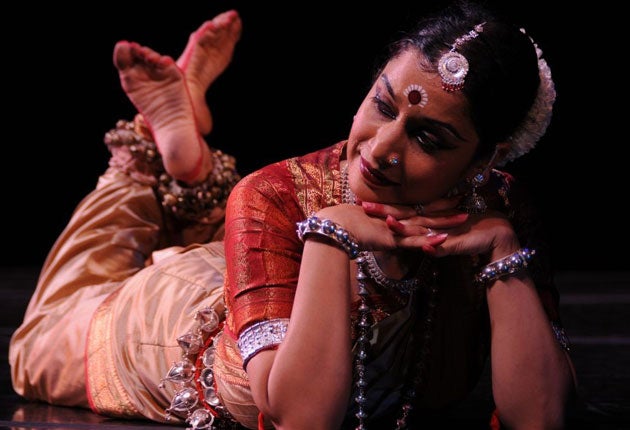Sriyah, King's Theatre , Edinburgh

Bijayini Satpathy has a terrifying stare. One of the three dancers of the Nrityagram Dance Ensemble, she performs storytelling dances in the Indian classical style Odissi. When she evokes the destructive qualities of gods and goddesses, she goes from feminine delicacy to a fierce glare, looking perfectly ready to dance the world to death.
In an Edinburgh Festival full of reinterpretations, Sriyah is a very traditional dance recital, from a company based near Bangalore. A quartet of musicians sit with their backs to the audience, facing the stage. Satpathy, Pavithra Reddy and company director Surupa Sen all perform in traditional costume, with beautifully pleated silks, jewelled belts and tinkling ankle bracelets. Sen's voiceover explains the concept of each number. In the more elaborate narrative works, one of the dancers will demonstrate the mime motifs, making it easier to follow the action.
All three dancers are beautifully supple, falling softly into delicately curved Odissi poses. Balances are serenely steady. Sen has created a range of numbers – a dance in praise of the mother goddess, an abstract demonstration of Odissi's forms, story dances and expressions of poems.
The dances are appealing, yet they could do with more variety. Some dramatic moments stand out but the company's style lacks contrast. These dancers are strongest in line and gesture, making less of their jingling footwork. Though there's always a close connection between musicians and dancers, the music ranges much further than the gentler dance.
The strongest number is the final Vibhakta, when Satpathy and Sen dance both the male and female principal. Switching from one to another, they have fun with the way Indian classical dance can pin down specific details: the flowing hair and curves of the female principal, his garland of skulls and swaggering stance. Since the male and female complement and celebrate each other, Satpathy and Sen get to dance extremes, and to blend them together.
The company's four musicians are superb. Rajendra Swain sings with velvety tone. He's matched by Sanjib Kunda on violin and Srinibas Satapathy on flute, with rippling percussion from Sibasankar Satapathy. The music is warm and lyrical, rushing urgently into ardent descriptions of gods and goddesses, or slowing into open, abstract musical patterns.
Join our commenting forum
Join thought-provoking conversations, follow other Independent readers and see their replies
Comments
Bookmark popover
Removed from bookmarks